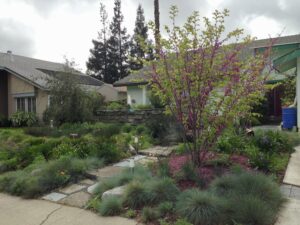Wildlife habitat, planted by a pro
By Debbie Arrington
 In Elk Grove, Soleil Tranquilli is a force for nature – creating wildlife-friendly habitat, one garden at a time.
In Elk Grove, Soleil Tranquilli is a force for nature – creating wildlife-friendly habitat, one garden at a time.
A professional landscape designer, Tranquilli has transformed scores of local yards into native plant-filled oases for birds and bees. That includes her own.
“This yard is a model to inspire others,” she says. “It’s also a form of service, putting my money where my mouth is. It’s a demonstration garden of a sort. How much habitat can we cram into a small garden?”
Packed with drought-tolerant natives and other low-water plants, her landscape has something blooming every season, from native bulbs to Showy Milkweed to Desert Mallow. The more native flowers, the better to attract pollinators.
“There’s activity going on all year, every day in our garden,” she adds. “From the sky above to the soil below our feet, it’s a mini, working watershed eco-system.”
Owner of Tranquill Gardens, Tranquilli designed her yard’s own makeover from thirsty lawn to sustainable paradise, using her own contractor and expertise. The transformation took patience.
“We left the yard mulched for eight years after lawn removal, concentrating on removing the Bermudagrass,” she explains. “During this preparatory time, we had tons of California poppies! Getting rid of the mower and using that storage space for other things was liberating!”
Besides water savings, no lawn has added benefits.
“Maintenance is the big story here,” Tranquilli says. “Generally, we simply blow off leaves and bloom confetti from our drive and pathways (and) manage dry poppy and bulb foliage. This is about once a month, or maybe as much as a few minutes every week during the spring when it’s really growing fast.”
Her favorite part of her garden? Her trees. “Right now, the shade is my favorite Summer Strong feature!” she says.
Besides her well-established shade trees, Tranquilli loves some of her more colorful additions such as ‘Bubba’ Desert Willow and California Redbud. Trees are a good starting point for lawn-to-habitat makeovers, she notes.
“I advise folks to think simple, think trees,” Tranquilli says. “Mulch the lawn, plant trees. Watch what happens and who comes to visit.”

